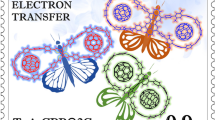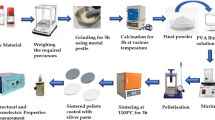Abstract
In the study of spontaneous exciting luminescence of polycrystalline BPh4NH4 structures, it was shown that observed luminescence is caused by triplet exciton states which are stable at low temperatures under dark conditions. Triplet excitons are formed when an electron is transferred from the anionic part of complexes to cations of neighboring complexes. The ATPB crystal structure makes it possible to switch ∼2% of complexes from states with S = 0 to the state with S = 1, i.e., to provide high density of data recording. Information is read when luminescence is excited and is erased when a structure is heated to room temperatures. Switching of ATPB states from S = 0 to S = 1 by light should be of interest for spintronics.
Similar content being viewed by others
References
T. Steiner and S. A. Mason, Acta Cryst. B 56, 254 (2000).
N. Malek, T. Maris, M. Simard, and J. D. Wuest, J. Am. Chem. Soc. 127, 5910 (2005).
S. A. Shapovalov, V. L. Koval, T. A. Chernaya, et al., J. Braz. Chem. Soc. 16, 232 (2005).
G. S. He, J. D. Bhawalkar, C. F. Zhao, and P. N. Prasad, Appl.Phys. Lett. 67, 2433 (1995).
U. Narang, C. F. Zhao, J. D. Bhawalkar, et al., J. Phys. Chem. 100, 4521 (1996).
C. D. Geddes, P. Douglas, C. P. Moore, et al., J. Heterocyclic Chem. 36, 949 (1999).
T. M. Polyanskaya, V. A. Nadolinnyi, V. V. Volkov, et al., Zh. Strukt. Khim. 47, 904 (2006) [J. Struct. Chem. 47, 894 (2006)].
W. J. Westerhaus, O. Knop, and M. Falk, Can. J. Chem. 58, 1355 (1980).
P. K. Bakshi, A. Linden, B. R. Vincent, and S. P. Roe, Can. J. Chem. 72, 1273 (1994).
I. Dance and M. Scudder, Chem. Eur. J. 2, 481 (1996).
V. A. Nadolinny, V. V. Vasilev, and I. P. Mikhalovskii, Phys. Status Sol. (a) 127, 135 (1991).
V. A. Nadolinny, V. V. Vasilev, and I. P. Mikhalovskii, Phys. Status Sol. (a) 116, 105 (1989).
Author information
Authors and Affiliations
Corresponding author
Additional information
Original Russian Text © O.V. Antonova, V.A. Nadolinnyi, E.A. Il’inchik, O.P. Yur’eva, A.A. Ryadun, 2009, published in Kratkie Soobshcheniya po Fizike, 2009, Vol. 36, No. 12, pp. 17–21.
About this article
Cite this article
Antonova, O.V., Nadolinnyi, V.A., Il’inchik, E.A. et al. Triplet exciton states in ammonium tetraphenylborate crystals. Bull. Lebedev Phys. Inst. 36, 356–358 (2009). https://doi.org/10.3103/S1068335609120045
Received:
Published:
Issue Date:
DOI: https://doi.org/10.3103/S1068335609120045




